WordPress Ad Server (CMAC) + Customer Dashboard - Use Case - How to Manage Video Ads and Let Your Users to View Ad Campaign Results
Use Case – How to manage video ads and let your users to view ad campaign results.
Video Use-Case
Note: This guide requires:
- WordPress Ad Server - This document uses version 2.0.4.
- Ad Changer Client - This document uses version 1.9.5.
- Ad Changer Customer Dashboard - This document uses version 1.0.4.
Introduction
WordPress Ad Server is an advertising plugin, designed to simplify the use and management of advertising campaigns on multiple WordPress websites.
It’s especially useful for companies that have several advertisement platforms on WordPress and therefore requires a banner server that manages and rotates banners from numerous advertising campaigns.
Ad Changer Customer Dashboard creates a dashboard for your customers to view and track their WordPress Ad Server campaigns. Customers can view only the campaign performance down to the level or each banner without the ability to change campaign settings.
Use Case Front-End
Randomized video banner embedded in the post:
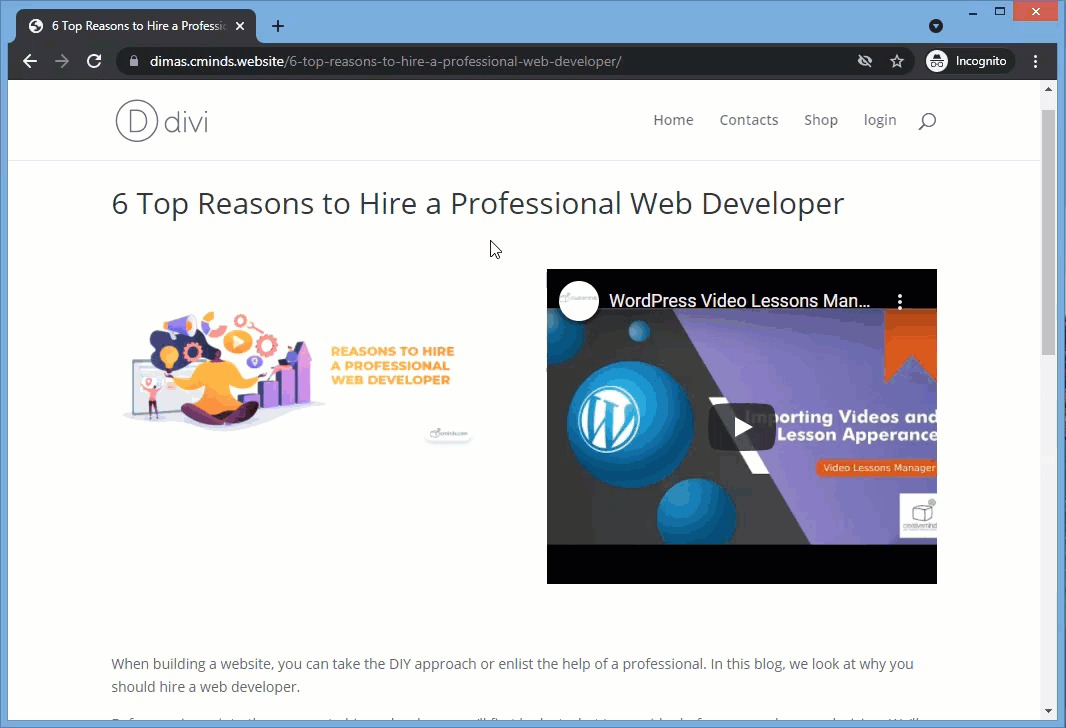
Customer Dashboard - Campaign Info:
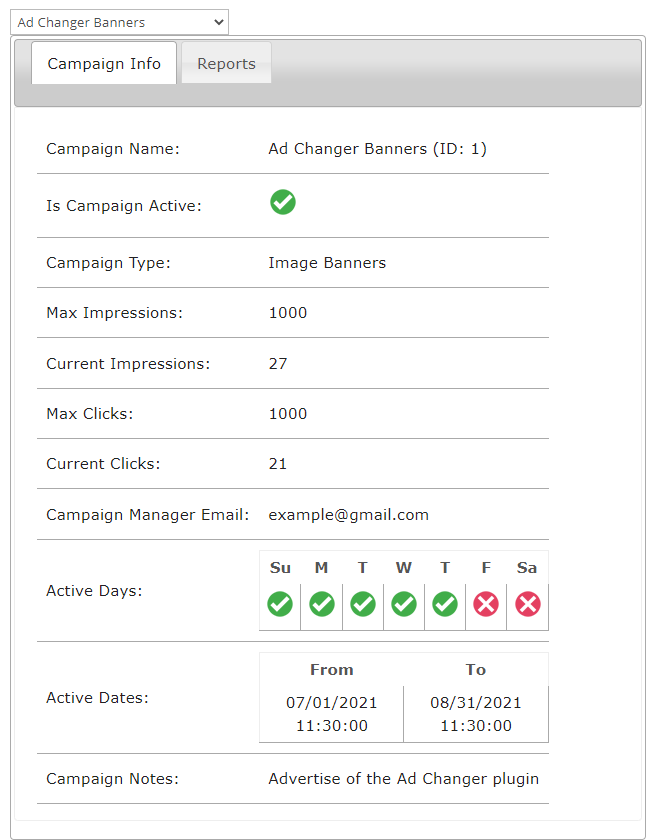
Customer Dashboard - Reports:
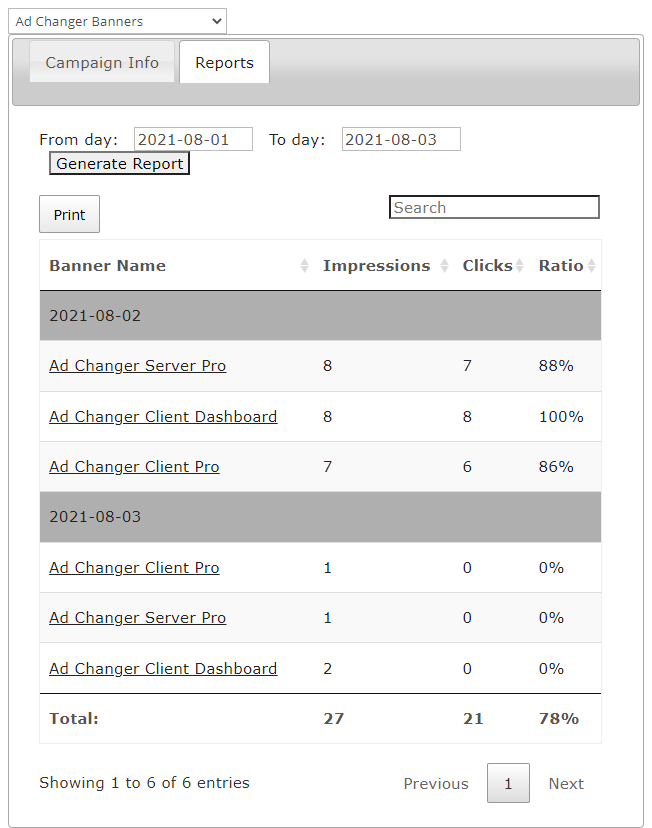
Use Case Assumptions
In this example we will consider how to create campaigns with video ads and let your users to view ad campaign results.
The WordPress Ad Server is an adverising plugin that consists of two separate kinds of plugins: WordPress Ad Server and Ad Changer Client - never install both of them together on the same site. Ad Changer Customer Dashboard should be installed on the site with WordPress Ad Server.
We assume that you've already bought the plugin and add-ons, but not installed them yet.
It follows:
- Installing the plugin
- Setting up
- Creating a campaign
- Setting up a campaign for client
- Customer Dashboard
- End Result
- Extra - Creating campaign groups
Installing the Plugin
The process is the same for all CM plugins and add-ons.

- Download the plugin from your customer dashboard.
- Log in to WordPress and navigate to the WordPress Admin → Plugins settings.
- Click on Add New.
- Activate it and add the license.
Learn more: Getting Started - Plugin Overview
Setting up
When the WordPress Ad Server is installed, first we need to configure it. Navigate to Admin Dashboard → Ad Changer → Settings.
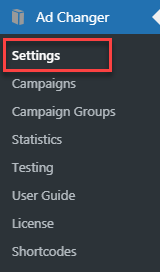
There you can find a few tabs with settings. Let's consider the options that we need for our use case.
General Settings
First tab is General Settings. The options are:
- Server Active - Defines whether the WordPress Ad Server is active to accept banner requests.
- Disable history functionality - Turn off data collection on clicks, impressions, etc. This may help improve speed and performance.
- Notification Email Template - Customize the text of email notification that will be sent if the ad campaign stops working on some reason.
- Inject JS libraries on ALL pages / in footer - Use in cases where the shortcodes are inserted within customized themes or other plugins. This is needed when banners are not showing up as expected on your pages, or when you are adding custom CSS styles to override settings and to better accommodate placement of the banner.
- Auto-deactivate old campaigns - Campaigns with selected activity dates, will be automatically deactivated when the last date passes.
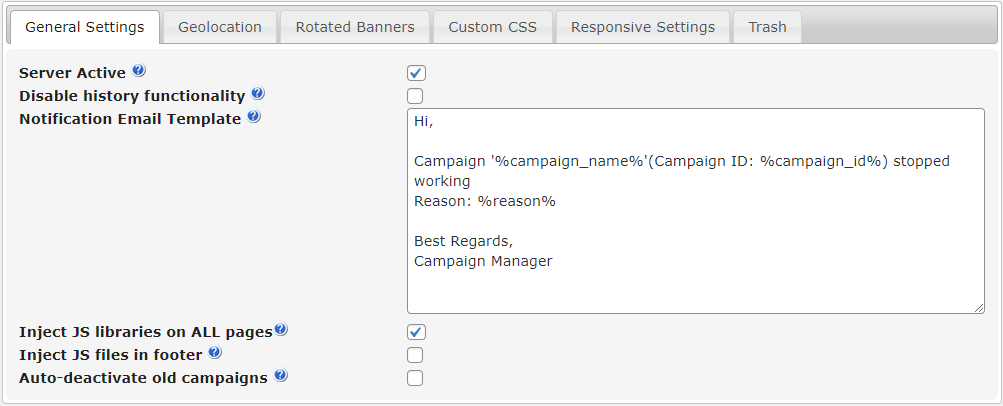
Geolocation
Second tab is Geolocation.
Server Geolocation Settings are implemented with an API developed by http://ipinfodb.com/, which can be used to show the geographical location of users accessing your ads in reports and statistics. Note: it doesn't let you define campaigns by geolocation.

Custom CSS
Next tab we need is Custom CSS.
Server Custom CSS settings relate to the layout of banners on your website. This setting overrides the style.css parameters in your WordPress theme.

Trash
Last tab is Trash. Here the admin can remove statistics between two set dates.

When everything is configured, don't forget to click the button Store Settings.

Creating a Campaign
Now it's time to create our first ad campaign. Navigate to Admin Dashboard → Ad Changer → Campaigns.
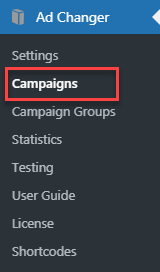
Click the button Create new Campaign at the top right of the page.

There you can see the form with three tabs that will help you to create a campaign. Let's consider them all one by one.
Campaign Settings
First tab is Campaign Settings.

The options are:
Campaign Name - Write here a name for the ad campaign. It will not be displayed on the front-end, this is for internal use only.

Adding campaign name Once the campaign is created, a new option Campaign ID will appear under the Campaign name. Here you can find the number - this is ID you need to use in the shortcode for placing the campaign in posts/pages.

Campaign ID Customer Dashboard Campaign Assigned Users - This option is provided by the Ad Changer Customer Dashboard. Here you assign users that will be able to see the statistics of this campaign. Just find needed users in the list Available Users and click on them - they will appear in the list Assigned Users. Note: the site owners of client sites must be registered on your site to be able to check Customer Dashboard Campaign and see the statistics of their campaigns.

Assigning users to the campaign Campaign Group - You can add the campaign to the group. Learn more about creating Campaign Groups.

Choosing campaign group Campaign Weight - Determine the campaign importance and priority in relation to all other campaigns to determine how often it should appear. This is important when used within a group of campaigns. Learn more about weight: WordPress Ad Server (CMAC) - Campaigns - How Weight Works (Chance of Display)

Setting up the campaign weight Campaign Notes - You can write here a note. It will not be displayed on the Front-end, it's for internal use only.

Adding campaign notes Target URL - Target URL for all banners in the campaign. Target URL specified in banner will override this. Note: clicks are counted only if it is set.

Adding target URL Open target URL in new window - If enabled, the target URL will open in a new window after clicking on it.

Opening target URL in new window Campaign Status - Disable this option if you want to stop the campaign.

Choosing the campaign status Campaign Manager Email - Write here the manager's email of the campaign. The notifications will be sent to that address.

Adding campaign manager email Send Notifications - Enable it to send email notifications to campaign manager when the campaign stops.

Enabling notifications Max Impressions - Set the number how many times the campaign should be shown before it stops. Set to 0 to make it unlimited.

Limiting impressions Max Clicks - Set the number how many times the campaign can be clicked before it stops. Set to 0 to make it unlimited.

Limiting clicks Approved Domains - Add a list of domains from which banners can be requested and served. Leaving this list empty will allow all Ad Changer clients to request the banners randomly without defined preferences.

Adding approved domains Advertisers - Name of the advertiser. You can choose it from the dropdown list of advertisers that you already added, or create the new one.

Choosing advertiser Custom JS - This field is designed to add custom JS codes into the page where the campaign ads are being displayed. The JavaScript code executes immediately, so it hooks into the banner click, shows modal, show alert, call AJAX, etc.

Adding custom JS
Campaign Banners
Second tab is Campaign Banners.

The options are:
Campaign Type - Pick the type of advertisements in the current campaign from the list of currently supported types. In this use case we choose Video Campaign.

Choosing the campign type - Learn more about all campaign types:
- Display Method - Choose the method of displaying the banners:
- Selected Banner - Will only serve selected banner.
Random Banner - Will serve random banner based on banner weight.

Choosing display method
Campaign Video Ads - Here you need to click the Add Video Banner button and paste a code with embedded iframe in the appearing area. You can add as many videos as you need. Here you also need to define the weight for each ad item.

Adding video banners
Campaign Activity Settings
Third tab is Campaign Activity Settings.

The options are:
Activity Dates - Define here the activity dates and time for the campaign. You can add one, two or more periods - depends on how many of them you need. To add a new period just click on the blue "+" icon.

Setting up activity dates Activity Days - Choose the activity days of the week for the campaign by checking the boxes.

Setting up activity days
At the end, when everything is configured, click the Add button to save the campaign.

Setting Up a Campaign for Client
When creating the campaign is done, we need to place it in the post or page.
First install the Ad Changer Client plugin to another website (remember: don't install the WordPress Ad Server and Ad Changer Client on the same website). We need to configure it for the beginning. Navigate to Admin Dashboard → Ad Changer → Settings.
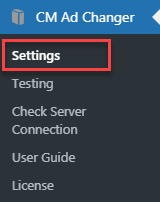
The settings here look very similar to the server side plugin's settings. The little difference is in General Settings tab.
- Client Active - Defines whether the Ad Changer Client is active. If it's disabled, no banners will be displayed by Ad Changer Client.
- Disable sending history data - Turn off data sending on clicks, impressions, etc. This may help to improve speed and performance.
- Ad Server domain - This specifies the URL address of the WordPress Ad Server plugin installation (i.e. where the WordPress Ad Server is installed).
- Server cache update timeout - Time in minutes between another call to to the site where WordPress Ad Server is installed for fresh data. Default value is 30.
- Flush cache now - Check it to get fresh data from the server now.
Inject JavaScript libraries on ALL pages/ on footer – Use in cases where the shortcodes are inserted within customized themes or other plugins. This is needed when banners are not showing up as expected on your pages or also when adding custom CSS styles to override settings and to better accommodate placement of the banner.

General plugin settings
After configuring click the button Store Settings to save the changes.

Now we can place the ad campaign to the post or page, or anywhere else on the website. The following steps are the same for the site, where the WordPress Ad Server is installed, and for the site where the Ad Changer Client is installed.
Every created campaign has it's ID. To place the campaign anywhere we need to use the shortcode [cm_ad_changer] with the parameter campaign_id="X", where X is campaign's ID. In our case the shortcode will look like this [cm_ad_changer campaign_id="4"]
You can insert it using the tools of usual post/page editor or using the tools of your theme.

Result on the Front-end:

Customer Dashboard
When the Ad Changer Customer Dashboard is installed, the page with a dashboard is created automatically. You can also place it on any page using the shortcode [cm_ad_changer_customer_dashboard] .
Reminder
The Ad Changer Customer Dashboard should be installed on the same site with the WordPress Ad Server.
The user can choose in a dropdown a company to view info about it. There will be available only those campaigns that have been assigned to that user by the admin. Let's choose one, for example with image banners:
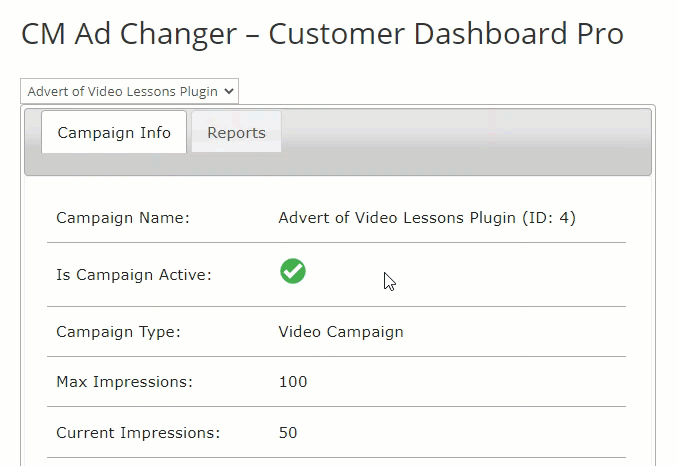
There are two tabs available in this tab - Campaign Info and Reports.
Campaign Info
In the first tab the user can see all available information about the campaign.

Reports
In the Reports tab the user can select the dates for which he wants to have the report to be generated. Just need to choose dates in the fields From day and To day, then click the button Generate Report.

The report shows the statistics about Impressions, Clicks and Ratio for every banner of the campaign per each day.

Once clicking on the print button a new report format will appear which is adjustable to the printing format:
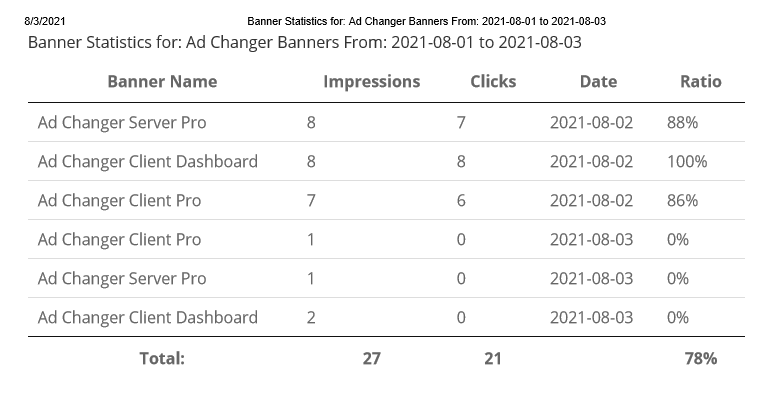
You can also hover over the banner names in the report and view the actual banner as it appears:

You can use the quick filter that can help you narrow results related to a specific banner:

End Result
Following instructions found in the plugin and guides you should be able to create an ad campaign with randomized video banners and provide a customer dashboard for your users.
Use Case Front-End
Randomized video banner embedded in the post:

Customer Dashboard - Campaign Info:

Customer Dashboard - Reports:

Extra - Creating Campaign Groups
You can unite different ad campaigns to the campaign groups. This way you can display banners from single ad campaigns - in a random way or rotated.
To create the campaign group navigate to Admin Dashboard → Ad Changer → Campaign Groups.
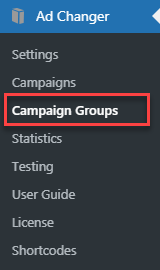
Then click the button Create new Group at the top right.

There you will see the form that you need to fill.
- Group Name - Write here name of the group.
- Group Order - Choose how the campaigns of the group should be shown.
- Campaigns In The Group - Choose needed campaign from the dropdown list and click the Add button.
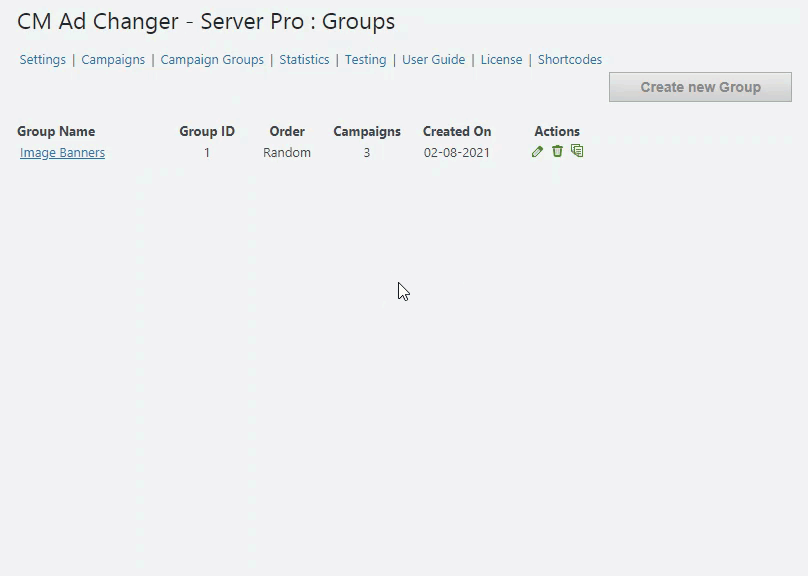
When the group is created, you can find Group ID in the information about the group.
You can display campaign group almost the same, as usual campaign. You need to use the shortcode [cm_ad_changer] with the parameter group_id. So, in our example, Group ID equals "3", so the shortcode will look like this [cm_ad_changer group_id="3"]
 |
More information about the WordPress Ad Server plugin Other WordPress products can be found at CreativeMinds WordPress Store |
 |
Let us know how we can Improve this Product Documentation Page To open a Support Ticket visit our support center |






















